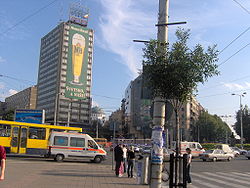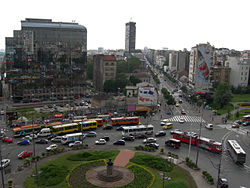- Slavija (Belgrade)
-
Slavija Square (Serbian Cyrillic: Трг Славија, pronounced [tr̩̂g slâːv̞ija]), officially Dimitrije Tucović Square (Serbian Cyrillic: Трг Димитрија Туцовића), is one of the central town squares and an urban neighborhood of Belgrade, the capital of Serbia. It is divided between the Belgrade's municipalities of Vračar and Savski Venac.
 Slavija Square - looking towards “Jat Airways Slavija Hotel” (centre) and Slavija Lux (far right)
Slavija Square - looking towards “Jat Airways Slavija Hotel” (centre) and Slavija Lux (far right)
The square was named after Serbian socialist Dimitrije Tucović.
Coordinates: 44°48′09″N 20°27′59″E / 44.8025°N 20.4664°E
Contents
Location
The Slavija square is located less than 1.5 kilometers south of Terazije, designated downtown of Belgrade, on an altitude of 117 [1] meters. The majority of the square itself belongs to the municipality of Vračar (eastern and central parts) while the western parts belong to the municipality of Savski Venac. The neighborhood which surrounds the square borders the neighborhoods of Cvetni Trg on the north, Vračar's sub-neighborhoods of Grantovac on the north-east and Englezovac/Savinac on the south-east, and Zapadni Vračar on the west.
History
Until the 1880s, the area of the modern Slavija square was a large pool on the eastern outskirts of the city, where the inhabitants of Belgrade went hunting wild ducks and boating on the pond. The formation of the square started when a well-known Scottish businessman and Nazarene Francis Mackenzie, bought a large piece of land above the present square and parcelled it for sale (the area became subsequently known as Englezovac). Soon after that, Mackenzie has built a house for himself at Slavija (at the place where the old "Slavija" cinema used to be), which in 1910 was turned into the Socialist People's Center, a gathering place of the worker's movement. The other, smaller buildings at the corner of Kralja Milana and the square, where the famous cafés "Tri seljaka" and "Rudničanin" used to be, were destroyed before and during World War II.
The Slavija was projected as the final square in a succession of squares around Belgrade's central route from Kalemegdan to Englezovac: Studentski Trg-Trg Republike-Terazije-Cvetni Trg-Slavija. In time, Studentski Trg and Terazije lost their square functions, becoming streets, while Cvetni Trg, with final changes in early 2000s, is completely defunct as a traffic object, so Slavija and Trg Republike remain as the rare true squares in downtown Belgrade.
After the World War II, the new Communist government re-buried the remains of the leading Serbian Socialist Dimitrije Tucović at the central square plateau in 1947 and a bronze bust of Tucović was erected, work of Stevan Bodnarov. In addition, the name of the square was officially renamed from Slavija (meaning "land of the Slavs") to the Square of Dimitrije Tucović. The name, just like most of the other Communist administrative name changes in the old core of the city didn't live up, and in early 2000s it was officially changed back to Slavija.
A hotel "Slavija" was built in 1962, and enlarged later (complex Slavija A and Slavija B). Third addition, ultra modern Slavija Lux was built in 1989. The square is also a home to the first McDonald's restaurant ever built in Eastern Europe, opened 24 March 1988 and still operational. The restaurant is in the former Vučo family house, constructed by Dimitrije T. Leko in 1893. The restaurant was heavily damaged during the protests following the proclamation of the declaration of independence of Kosovo on 17 February 2008.
Traffic importance
Slavija is one of the most vibrant traffic objects in Belgrade, being one of the major squares of Belgrade. It is one of the rare traffic routes in the city where all three types of public transportation (buses, trolleybuses and trams) meet. Due to the general inadequacy of the city's transportation, traffic jams are regular on the square and especially hard if helped by some additional reason (bad weather, snow, especially the 2006 reconstruction of the Autokomanda interchange, etc).
The transportation importance of the square can be seen as it branches into the eight streets:
- Boulevard of Liberation, which goes up and down the Vračar hill and connects it to Autokomanda and the highway;
- Svetog Save, which also goes up the Vračar hill and ends up at the Temple of Saint Sava;
- Makenzijeva, which also through Vračar connects it to the neighborhood of Čubura;
- Prote Mateje, which connects it to the Belgrade's longest street, Boulevard of the King Alexander;
- Beogradska, which also connects it to the Boulevard of the King Alexander, and the neighborhood of Tašmajdan and further to Palilula;
- Kralja Milana, the main street of Belgrade, going through downtown (Terazije) and further to the Square of the Republic and Kalemegdan;
- Nemanjina, which connects it to the main railway and bus stations and the bank of the Sava river;
- Deligradska, which connects it to the vast complex of the Clinical Center of Serbia;
Architecture
Due to numerous and constant changes in the architectural structure of the urban tissue surrounding the square, Slavija became a synonym for an architectonically ugly and devastated area and the source of one of the most popular urban legends in Belgrade: the curse of the Mitićeva rupa ("Mitić's hole").
Mitićeva rupa
One of the richest people in Belgrade before World War II, Vlada Mitić, bought the lot on Slavija to build the largest department store in the Balkans, but the outbreak of the war halted the realisation. After the war, Communist government imprisoned Vlada Mitić and confiscated his entire property, including the lot on Slavija, on the corner of the Kralja Milana and Beogradska streets, and money prepared for the construction of the department store. From 1946 to 1980 26 different project were completed for the lot, but none was realised. Then mayor of Belgrade, Bogdan Bogdanović decided to put a large sundial in the place. In the early 1990s, Dafiment banka, one of the major pyramid schemes of the Milošević's regime, bought the lot and announced a monumental shopping mall, but after the scheme failed completely, now fenced lot was turned into the dump (technically, it was in fact a Ponzi scheme). After the regime change in 2000, the area was cleaned and a temporary park was built instead. The failed projects continued, including the ultra-modern, gigantic shopping mall by Israelis which turned out to be a complete hoax. All of this was more than enough for people to consider the "hole" a cursed place.
Cinema Slavija
On the place of the residence of Francis Mackenzie, a cinema "Slavija" was built, from the Beogradska to Prote Mateje streets. For decades one of the symbols of Belgrade, the cinema was demolished in the early 1990s, but like the Mitić's hole, none of the projects for construction on this site have been realised. Not knowing what to do with the empty lot, city government turned it into the temporary parking lot.
Slavija hotels
There are three Slavija hotels on the square:
- Slavija A, between the Makenzijeva and Svetog Save streets, right on the square;
- Slavija B, also between those two streets but behind the Slavija A (to which it makes one complex), further from the square;
- Slavija Lux, across the old hotels, between the street of Svetog Save and the Boulevard of the Liberation;
The old hotel Slavija from 1962, in the manner of the International style is today viewed by the Belgraders as an obsolete and ugly building, with its hospital-like look, especially compared to the modern marble and glass Slavija Lux which perfectly fits into the buildings behind it. Inside the hotel is elaborately decked out with wooden panelling on most surfaces in the rooms. It features a Casino and large dining room. The Hotel has not been fully renovated since 1962 and still operates fully, though not using all rooms.
National bank of Serbia
 New building of the National Bank of Serbia
New building of the National Bank of Serbia
Construction of the new building of the National Bank of Serbia also began in the early 1990s. It is located a little bit further from the square itself, but due to its size it is visible from many parts of Belgrade. Money problems caused a decade and a half of delays. A massive construction was deemed ugly and unappropriate for the location by many Belgraders and in 1994 the then governor of the bank, Dragoslav Avramović, said that he will not move into the new building even if it will be done on time. However, a massive glass building was finally finished only in 2006. Some old houses and small building were demolished for the construction of the bank, but some remained right next to it as a contrast. The terrain surrounding the building has not been landscaped to date (2011).
References
External links
Neighbourhoods of Belgrade's Vračar municipality Crveni Krst • Cvetni Trg • Čubura • Englezovac • Gradić Pejton • Grantovac • Kalenić • Krunski Venac • Neimar • Pašino Brdo (northern part) • Savinac • Slavija • Vračar (neighbourhood)Categories:- Neighborhoods of Belgrade
- Squares in Belgrade
Wikimedia Foundation. 2010.


